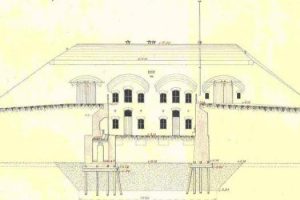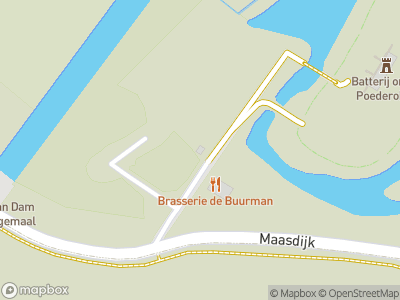The battery in the village of Poederoijen, Batterij onder Poederoijen, was built around 1880 as part of the New Dutch Waterline. Its purpose was to flood the western part of the Bommelerwaard region between the Waal and Maas rivers at any threat of war. The battery´s artillery had the task of monitoring the Maas river and protecting the floodgates. The battery has been refurbished and is now open to the public.
Maas and Waal rivers
The battery in Poederoijen is called Batterij onder Poederoijen, and was part of the fourth and final expansion of the New Dutch Waterline. The cannons that were new during the Franco-Prussian war (1870) had proven the Waterline somewhat out of date. It had also proven the strategic position where the Waal and Maas rivers meet, in special need of renovation.The battery in Poederoijen was intended for guarding the river Maas and monitoring the floodplain in the Bommelerwaard region together with the battery at Brakel. In doing so, they also provided protection to the ancient fortifications in Loevestein and Woudrichem. The artillery in Poederoijen was also expected to protect the floodgates.
Brakel and Poederoijen
The completion of the two batteries took a very long time due to the serious subsidence caused by the marshy landscape. The construction period lasted from 1879 until 1886 and the plans had to be adjusted several times due to the difficult conditions. The two batteries were almost identical. They each had a central bombproof building made of brick and were covered with 2 metres of earth on the eastern side facing the enemy. On the western side, the buildings had three floors. Each battery was surrounded by a moat and was only accessible via a wooden bridge.
Nature preservation
There were guard houses, administrative buildings and storage depots in the grounds of each battery most of them gone now. The surrounding embankments around both batteries were dug by the military in the 1950s and the two sites are now managed by the Foundation for the Conservation of the Waterline – Bommelerwaard(Stichting Behoud Waterlinie Bommelerwaard). The terrain around each battery has been designated as a protected nature reserve, and the bridge and the main building at Poederoijen have been restored and opened to the public. The battery in Poederoijen is now a perfect combination of nature and cultural history.















